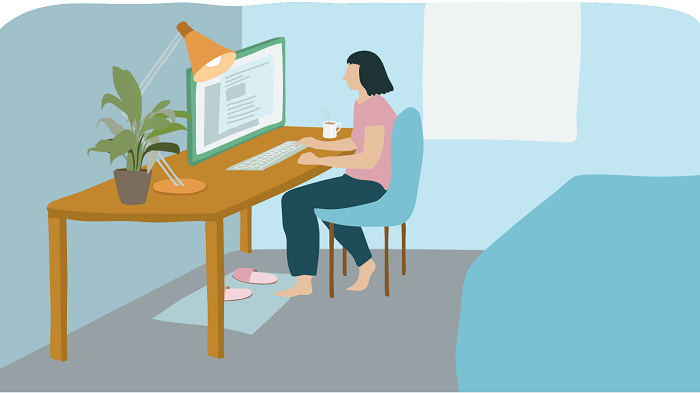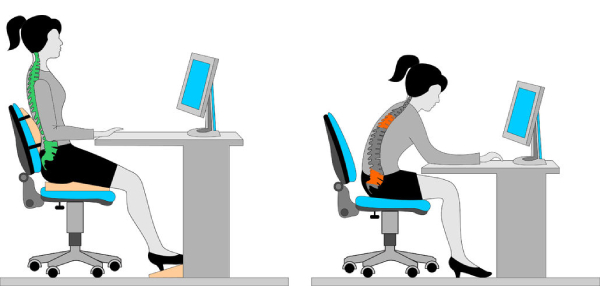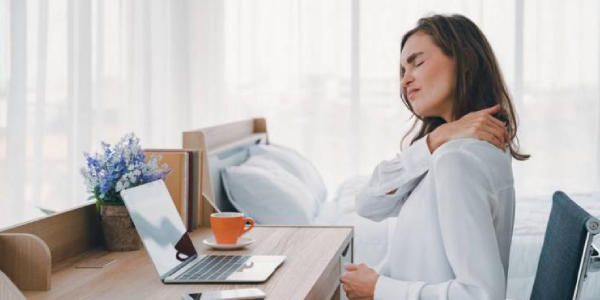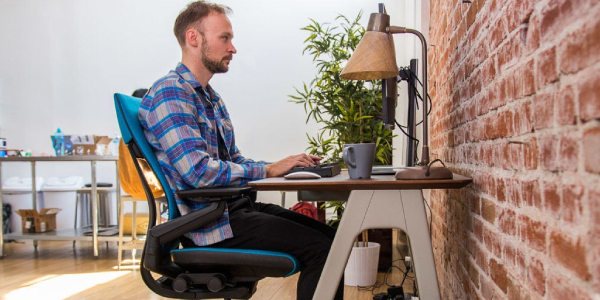Basics of Office Ergonomics
Many people are unaware that poorly designed computers and workplaces with poor working habits with modern office furniture can cause serious health problems. Neck and shoulder pain, hand and wrist pain, headaches and eye pain are common symptoms of bad design habits.
Chair
A chair with five wheels is more durable than a chair with four wheels.
A chair with 5 castors on the base provides stability. It is easy to knock the four castors off the seat.
Check that your chair is at the right height. If this is not the case, you must order a replacement cylinder from your chair manufacturer.
Seat
If your seat is too low, the part of your legs that comes into contact with the seat can cause other problems. When you sit in a high chair, you put more pressure on your legs, which can reduce blood flow.
The weight of your upper body is carried by the vertebrae of the spine at the bottom of your lower back. The backrest of the chair is shaped backwards for protection. The chair is adjustable to suit your low backrest.
The same vertebrae can also be a source of back pain. A chair with lumbar curvature can support and relieve these vertebrae.
An armrest is a form of furniture that is used to support the arms of the user. Armrests are usually height-adjustable
Armrest
If the armrests are too high, you must shrug your shoulders to use them, which can lead to shoulder and back fatigue. You can end up sitting on an armrest because it is too short.
Start by turning the chair from bottom to top. Start at the bottom level and work your way up.
When adjusting a chair, you should make sure that it adapts to you. Consider things like desk height and keyboard. People often adjust their chair so that it has a greater range of the keyboard, or adjust it so that a keyboard shelf is added to raise the keyboard to the correct height.
Adjust your chair height so that the top of the seat shell is level with the bottom of the kneecap. When you are sitting in your chair, adjust it so that your legs are parallel to the floor. Adjust it so that your legs are parallel to the floor. When adjusting the pan, you should have about three fingers or a fist-width distance between the back of the calf and the front edge of the chair so that your back meets the back.
Be aware that there are three specific attitudes that need to be observed, namely forward, backward and forward.
When lying down, the seat is flat. The lumbar spine curve of the back is able to fit smaller than the back. The usual posture requires an even swivel or tilt of the seat, but does not need to be changed. Start by lifting the chair up and then lowering it down when it feels comfortable.
If the chair lacks sufficient lumbar support, you should add a lumbar cushion. Make sure that the upholstery does not shorten the seat shell.
In an inclined position, the back should be slightly inclined. The seat angle between the thighs and the back should be greater than 90 degrees. The standard tilt posture to the front is to move slightly backwards. If you feel the chair retracting, you can adjust the backrest until you feel straight.
An armrest is a form of furniture that is used to support the arms of the user. It is also referred to as recovery or support. Armrests prevent you from reaching for a mouse, pulling down your desk, or anything else with an armrest in the way, so stop using it when it is removed. As mentioned above, armrests can interrupt work.
It is not a good idea to type with your arm while sitting on an armrest. Raise the armrest so that it sits above your elbow and your arm is bent 90 degrees in the chair. Repeat the opposite shoulder and check twice if the armrest is the same height.
Adjust the arm of the inward-facing armrest to your elbow with the upper arm and shoulder relaxed. When you reach for the keyboard, turn the armrest so that the armrest is inwards under the forearm. If you can’t reach your elbow, grab another armrest. For certain armrests, adjust the angle and width of the pivot so that everything slides inwards.
Footrest
Use footrests only as a last resort. Footrests can be used to change posture and protect feet if the chair is not lowered. Use a footrest on a chair that is high enough to provide only one position for the footrest.
It is important to adjust the posture when using a footrest. Adjust the footrest so that your thighs are parallel to the floor and allow a 1 / 3 inch difference. The footrest height should also be adjustable.
Some footrests have a rocking function that allows the user to swing back and forth on the footrest to promote blood circulation and prevent static posture. Because of the rocking motion, plastic feet seem to wear out faster, so look for ones that are durable.

Wrist
Look for a wrist support that is not surrounded by a hard plastic case. Foam wrist supports do not distribute pressure as well as gel wrist supports, and they can cause pressure points at the edges. When the wrist support has a soft surface, it facilitates a straight wrist and reduces pressure on the wrist.
Select a pause that is no higher than the front edge of the keyboard. When the wrist support has a prominent peak, as many mice do, it concentrates the weight of the wrist on a small area and is unsuitable. When the pressure is evenly distributed, the rest should be wide and round. Wrist rests that are too high on the keyboard force the user into a clumsy posture to operate the keys.
Monitor
A monitor is a tool to keep track of what is going on. There are two types of monitors today: CRT monitors (traditional box) and LCD monitors (thin flat screens). Core monitors are more expensive than LCD monitors because they require more space.
The dot spacing affects the transparency of the displayed image. The smaller the score gap, the better. The recommended minimum quality is 0.27, but a point spacing of 0.26 is often desired. A high-dot pitch monitor can handle the high resolution required by many modern computer programs without flickering.
Screens
Flickering can lead to fatigue and discomfort of the eyes. The refresh rate of a CRT display is 60Hz. This describes how quickly the image is redrawn on the screen.
The standard refresh rate is 60 Hz, but many people are sensitive to lower refresh rates, causing the screen to flicker. It is recommended to have a refresh rate of 70 Hz or higher when used.
Consider whether to use an aperture or buy one. The bright glow of the screen reduces the amount of light that is reflected from the screen into the eyes, which can be tantamount to washing the image out of the screen. Some displays combine these two features. Privacy screens are used to prevent someone else from seeing the computer by standing to the side of the screen.
The use of anti-glare masks is the same as looking at the screen while wearing sunglasses. If you are using a screen, you cannot move the display away from the glare-producing light source by turning off the light that lights up the panel (see “How do I adjust my monitor lighting”. Here’s a darker picture of a phone.
This may in some cases match your monitor’s privacy criteria. Look for glare on the screen and polarize the surface to reduce glare. Another technique is to use sunglasses to reduce bright light and maximize the illumination of other objects.
Some privacy screens require the user to stand directly in front of the privacy screen. Others may find it hard to see the bottom. Don’t look for one with a wide viewing angle; if the person sitting at the monitor goes, the screen can block their view. If the information on your screen is so sensitive that people need to switch to another display, you may need a more restrictive privacy screen instead.
Place the screen in front of a camera and make sure that reflections from the screen are minimized. Take a look at what is shown on the screen.
As you can see, it adjusts the brightness and contrast settings on the monitor. There is no difference in the brightness of the monitors.






